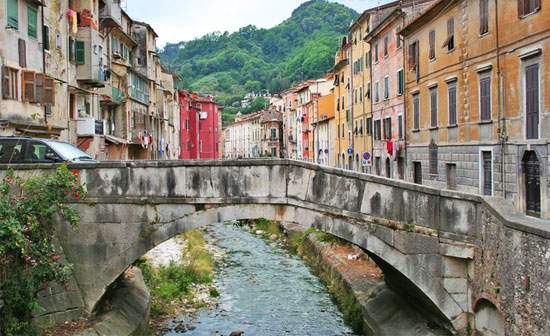When you want to refer to a union, a passage or a connection, I think the most commonly used image is that of the bridge. But the bridge is also a metaphor for change, for life flowing and being renewed. Sous le pont Mirabeau coule la Seine / Et nous amours, “Under the Mirabeau bridge flows the Seine and our loves,” goes a poem by Guillaume Apollinaire. The historic bridges of a city have witnessed the events that have occurred in that city, have seen people of every language and nation pass over them, have witnessed the evolution of society, perhaps have even been places for friends or lovers to meet. But, even without wanting to be romantic at all costs, historic bridges are a precious memory of our past and part of our cultural heritage.
In Carrara, the city where, as you know by now, we at Finestre Sull’Arte have our “base,” a mayor would like to erase in one fell swoop an important part of the city’s past by tearing down all the ancient bridges in the historic center. This is because a study conducted by Professor Giovanni Seminara of theUniversity of Genoa, and funded by the Region of Tuscany with the remarkable sum of 91,463.40 euros, thought that the best way to avert the risk of flooding in the city is precisely to eliminate all the bridges and footbridges that cross the Carrione stream in Carrara’s historic center.
These are bridges that have centuries of history, many of which bear evocative names. A legend that is told in the town (and which I admit I have only recently discovered), also revived recently on Carrara’s social media groups by a citizen, Michela Viti, tells that the names of the three main bridges in the center of Carrara (in order, from the mountain to the sea, the Ponte della Bugia, the Ponte delle Lacrime and the Ponte Baroncino) have to do with the tragedies that, from time immemorial, have disrupted work at the marble quarries. It is said that the family members of quarrymen who suffered fatal accidents at the quarries used to gather on the Bugia bridge to wait for news of their relative, and foreshadowing how it would turn out, they would try to hearten each other by telling each other that nothing serious had actually happened... they would, in short, tell lies to console themselves. However, when they realized that the reality was something else, the Bridge of Tears was the place where they let themselves go in despair. And finally, the coffin of the poor unfortunate man was loaded onto a cart ( baruzín in Carrara dialect) near the Baroncino bridge. Along with these three bridges filled with history and dating back to remote eras, the Groppoli Bridge, which some would even date back to Roman times (but more likely was built during the Middle Ages), the San Martino Bridge, a witness to the nineteenth-century developments in the stone industry when the workshops of Guglielmo Walton’s company were built in its vicinity, and in general all the crossings in the city center that bypass the Carrione River, would also be destined for demolition.
 |
| Carrara, a beautiful image of the Bridge of Tears taken by fototoscana.it (Creative Commons license) |
It is true that Carrara has experienced a truly disproportionate number of floods in recent years: the Carrione has overflowed several times, most recently on November 5, 2014, with disastrous outcomes. Despite this, the city’s administrators have never thought to do anything to investigate how mining activities are carried out at the marble quarries, which many say are primarily responsible for the Carrione’s now unsustainable problems. Only this summer, the chief prosecutor of Massa and Carrara, Aldo Giubilaro, opened a file for culpable landslide and flooding against four marble entrepreneurs, accused “of failing to dispose, for years, perhaps even decades, of debris from quarrying,” which, accumulated in the yards of the quarries, in the Apuan Alps, ends up in the waterways obstructing their normal course, or raising their level. A 2007 study conducted by theUniversity of Siena showed that it is “enough to have 60 mm of rain in 5 hours, with an intensity of only 14 mm in one hour” to trigger, on the ravaneti (the slopes where the processing residues accumulate), the movements of the so-called debris flows.
The same problems also apply to the disposal of marmettola, the waste dust from marble processing, which when deposited on the bottom of waterways destroys their ecosystems. The result is that rivers and streams in and around Carrara are heavily polluted, and their levels have risen over the years. And even in the aftermath of the tragic flood of November 5, 2014, there were those, such as geologist Mauro Chessa, who pointed the finger at excavation debris. Similar investigations had also started after another disastrous flood, in 2003: the twenty-two defendants would suffer no conviction because in 2011 the crime of manslaughter and flooding, with which they were charged, fell under the statute of limitations.
However, Mayor Angelo Zubbani did not deem it necessary to listen to either the University of Siena, or the environmental associations operating in the area, or the many Apuan geologists who have dedicated their professional activities to the very serious problem of hydrogeological instability in the Carrione River, or even less so the citizens of Carrara who are calling for shared solutions. No: the mayor of Carrara, interviewed about Seminara’s study, reiterated that “safety must prevail over everything” and that “we will be guided by priorities.” Of course, no one questions the fact that citizens’ safety should come first (that goes without saying). What is questioned, rather, is the validity and real effectiveness of a highly invasive and impactful study when, for years and from multiple authoritative sources, the city administration has always been presented with another solution: that of intervening in upstream activities. Invasive (indeed: destructive, in this case) intervention on the historical heritage should be thelast resort, when one is faced with a situation such that there are no more alternative solutions and there is nothing else to do. In Carrara, however, the opposite happens: in order not to touch the interests of themarble industry, it is preferred to consider a study according to which the solution would be the demolition of the city’s historic bridges.
A study that, moreover, examines only a section of the creek (the one that passes through the historic center of Carrara) and that has also raised doubts about the timing: in fact, the resolution was approved in August (regional resolution No. 3952 of August 26, 2015), but the results of the study came after just one month. Only one month to study a creek? Architect Claudia Bienaimé, city councilor, pointed this out to the mayor, who responded by saying that Seminara “began his study in December 2014 and that the date of the resolution is due to purely formal issues.” But the awarding of an assignment should take place, according to law, “after the verification of the possession of the prescribed requirements,” according to Article 11 of Legislative Decree 163 of 2006, which regulates public contracts. Given that the University of Genoa’s proposal came in July, one wonders if there is something wrong either with the process of awarding the assignment, or with the timing of what would perhaps become one of the fastest studies in history.
We are certain that the Superintendence will not allow Carrara’s historic bridges to be torn down. But the affair nonetheless gives us much to think about: we wonder how it is possible to be administered by a mayor who, in order not to harm certain interests, immediately declares himself ready to follow the unfortunate advice of those who would like to eliminate centuries-old historical testimonies from the center of his city. We wonder how a city can trust an administration that assesses light-heartedly, and without making too many scruples, the possibility of giving the go-ahead to a destructive intervention that would like to make rubble of the city’s heritage. We wonder how a mayor can constantly avoid a healthy confrontation with his administered people: for years Carrara has been asking that at least upstream interventions be tried, as suggested by several studies on the subject. But little or nothing has been done. Of course: it is much easier to destroy than to think. The great art critic Bernard Berenson, in his 1941 essay Aesthetics, Ethics and History in the Arts of visual representation, imagined a world “governed by biologists and economists in the guise of Platonic guardians, who would not tolerate any kind of activity or any kind of existence that did not contribute to a strictly biological or economic end.” The mayor of Carrara, depriving the city of its memory, could be an ideal administrator for the terrifying world Berenson hypothesized.

The author of this article: Federico Giannini
Nato a Massa nel 1986, si è laureato nel 2010 in Informatica Umanistica all’Università di Pisa. Nel 2009 ha iniziato a lavorare nel settore della comunicazione su web, con particolare riferimento alla comunicazione per i beni culturali. Nel 2017 ha fondato con Ilaria Baratta la rivista Finestre sull’Arte. Dalla fondazione è direttore responsabile della rivista. Nel 2025 ha scritto il libro Vero, Falso, Fake. Credenze, errori e falsità nel mondo dell'arte (Giunti editore). Collabora e ha collaborato con diverse riviste, tra cui Art e Dossier e Left, e per la televisione è stato autore del documentario Le mani dell’arte (Rai 5) ed è stato tra i presentatori del programma Dorian – L’arte non invecchia (Rai 5). Al suo attivo anche docenze in materia di giornalismo culturale all'Università di Genova e all'Ordine dei Giornalisti, inoltre partecipa regolarmente come relatore e moderatore su temi di arte e cultura a numerosi convegni (tra gli altri: Lu.Bec. Lucca Beni Culturali, Ro.Me Exhibition, Con-Vivere Festival, TTG Travel Experience).
Warning: the translation into English of the original Italian article was created using automatic tools. We undertake to review all articles, but we do not guarantee the total absence of inaccuracies in the translation due to the program. You can find the original by clicking on the ITA button. If you find any mistake,please contact us.